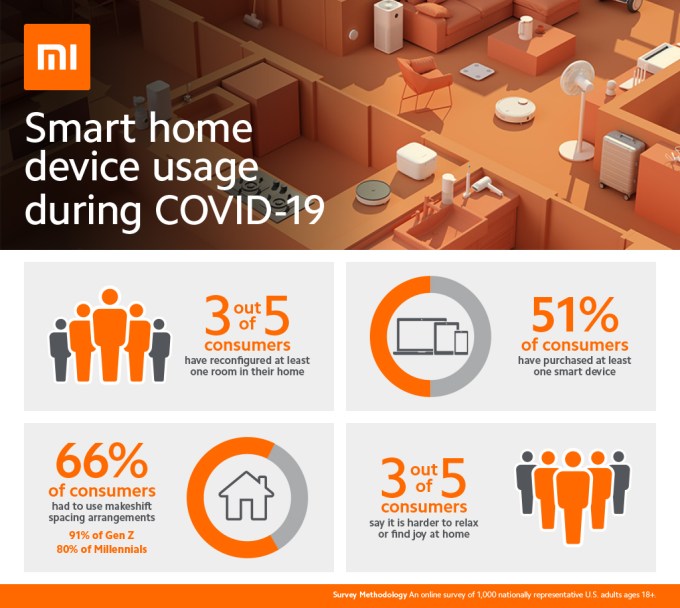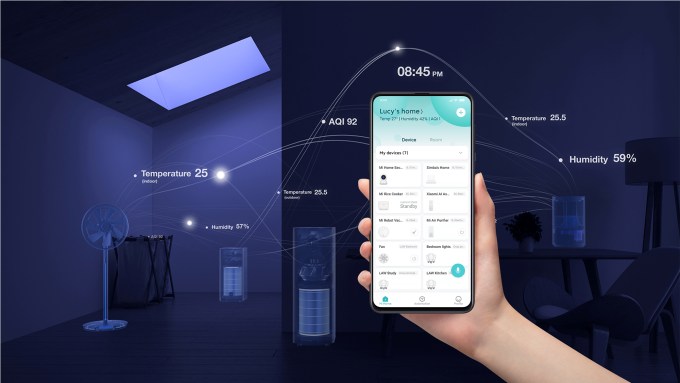Life during the pandemic has changed the very notion of space in America. More and more people are reconfiguring their homes to meet new functional requirements. A recent survey by Xiaomi found that 63% of consumers have reconfigured at least one room in their home. The dining room that was used for family meals is now a shared workspace or a classroom. The guest bedroom is now an at-home boot camp or Peloton studio.
In the same Xiaomi survey, 70% of consumers said they have set up or improved something in their homes due to spending more time there — and for many that something new was a smart device. On average, consumers have bought two new smart devices since March in response to being home more during the pandemic. In many ways, this is an acceleration of the trend towards smart living which has always been about reimagining and reinterpreting physical space to solve problems and adapt to new realities through the use of technology. Consumers overwhelmingly understand this, with over 80% believing that there are significant advantages to outfitting their homes with smart devices.
Consumers are seeking solutions in a COVID-19 and post-pandemic world and exploring how smart home devices can help them adapt to the new normal:
Creating or adapting new spaces that can serve multi-purposes

Image Credits: Xiaomi (opens in a new window)
According to Xiaomi’s survey, makeshift arrangements to adapt to stay-at-home orders were rampant. Nearly two-thirds (66%) of all respondents said that they had to use makeshift spacing arrangements in response to staying home more during the pandemic, with 91% of Gen Z consumers and 80% of Millennials indicating they had to make these changes. Creating workspace was particularly important, as nearly one-third of respondents have set up or improved a work environment amid COVID-19. Turning traditional devices into smart ones can help people solve the unique challenges of working from home. For example, with devices such as a smart TV Stick, users can turn their TV into an additional screen through Chromecast to provide additional or larger screens for working from home. Automation can also increase productivity and efficiency, such as creating the right ambiance with smart lighting that adjusts to the time of day, setting the right temperature, and creating (or managing) background noise can help create a productive environment. A fully-connected home that is streamlined and provides specific setups can address new problems generated by more time at home, such as the need to carve out specific work or study space. Smart home devices can have a long-term impact on how a home is set up, facilitating updates and changes that will benefit the home beyond stay-at-home orders.
Designing new, fun environments for at-home entertainment, for adults and children
The survey found that three out of five respondents said that since their leisure and work environments have become one, it has become harder to carve out personal space to relax and find joy at home. Of those, 63% purchased smart home devices, 82% adapted a room for working from home during COVID, and 79% reconfigured at least one room. Before COVID-19, people would leave their homes for entertainment or to relax; but now, many are seeking inspiration and innovative ways to enjoy their time at home; Smart home entertainment devices nowadays are mostly well integrated with service providers like Google and content providers like Netflix. a steady stream of new content; when used in conjunction with smart lighting and other IoT devices, families transform a day-time living room to an evening movie theater in the palm of their hand. This is just one example of how smart home devices are helping us reimagine the multitude of uses for our physical space.
Focusing on healthier and more productive homes
If stay-at-home orders are to go into effect again in 2021, 86% of consumers say they would prioritize a change to better their life. One of the largest focuses in 2020, and going into 2021, is creating healthier habits, which can start at home, and be facilitated by automated systems that streamline the adoption of new routines. A clean home has never been more important, and for many, never more difficult with more people at home more frequently. One of the key goals of a smart home is to make life easier for its inhabitants and help simplify everyday tasks, including cleaning. The ability to control smart appliances like air purifiers, vacuum cleaners, and even a smart kettle remotely, all in one place, means increased efficiency and streamlined processes every day; and COVID-19 has accelerated the adoption of these systems.

Image Credits: Xiaomi (opens in a new window)
Xiaomi adopted a unique business model that prioritizes innovation by incubating a large number of companies in a broad collaboration network. The result is the most diverse smart device product portfolio in the industry, with over 2,000 lifestyle and IoT products working together seamlessly in a connected ecosystem with smartphones at the center. Xiaomi’s tremendous growth shows that their strategy is working. As of September 30, 2020, the number of users with five or more devices connected to Xiaomi’s AIoT platform reached 5.6 million. Much of this growth is coming from overseas markets. Revenue from IoT and lifestyle products in overseas markets increased by 56.2% year-over-year, reaching a historical high, representing 55% of total revenue in the third quarter of 2020.
The pandemic has altered daily habits and norms forever. Xiaomi’s survey found that 60% of consumers say they plan to continue using their home for activities typically done elsewhere, even after a COVID-19 vaccine is widely available. Moving in 2021, the adoption and integration of smart home technology will be a prevailing trend in home improvement.